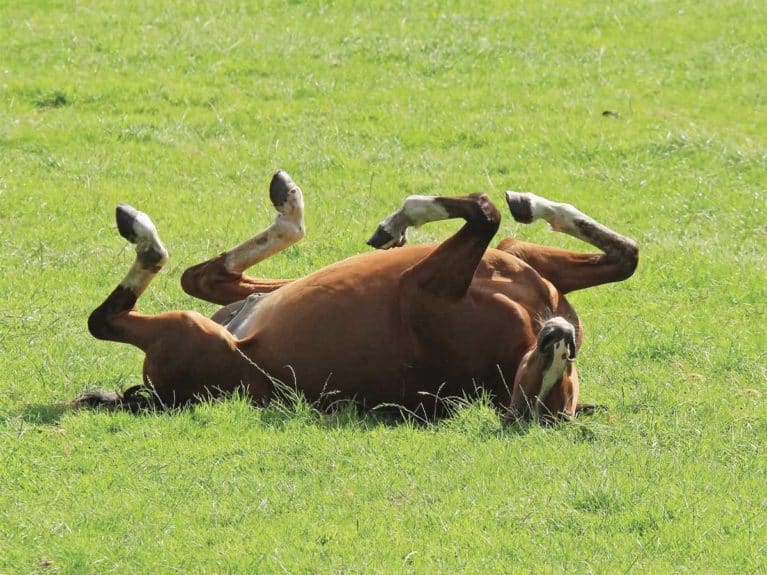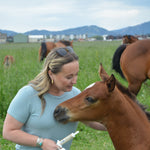When Something is Off: First Signs of Colic in Horses
September 3, 2020

Key Points:
- Colic is a general term for abdominal pain that can result from any number of things.
- Subtle symptoms of colic in horses include flank watching, stretching out as if trying to pee, and lying down frequently.
- Relay even the vaguest of signs to your veterinarian – doing so will help him or her pinpoint a cause and recommend what to do until he or she arrives.
- Most horses experience colic because their intestines have slowed for some reason. Get the gut moving!
Colic is a general term for abdominal pain caused by any number of things, from intestinal blockages to fatty tumors in the horse’s digestive tract. More often than not, you won’t know why your horse is colicking – diagnosing the problem is your veterinarian’s job. Your responsibility as a horse owner is to be vigilant for the early signs of discomfort within that long, winding gastrointestinal tract so you and your vet can intervene quickly and successfully.
The Progression of Pain
Often, the first signs that a horse is experiencing abdominal pain are subtle – so much so that they can go unnoticed.
“There are some very mild symptoms that many people don’t see,” says Dr. Keith Latson, an equine surgeon and co-founder and director of operations at FullBucket, a veterinary-strength supplement business based in Weatherford, Texas. “It may just be that a horse didn’t clean up all of its feed today or hasn’t passed manure recently. There are no real overt signs of pain in the horse, but something’s not quite right.”
If you’re observant, you might spot telltale colic symptoms such as a horse looking at or nipping at his sides. He might appear as if he’s trying to scratch an itch on his back or stretching out his hindquarters. Or maybe your horse keeps camping out like he’s about to pee.
These are normal activities, but maybe today they’re happening a lot more often than usual, says Latson. “But that’s something that you may only notice if you’re standing there watching that horse for a long period of time,” he notes.
If you’re seeing these behaviors persistently throughout the day, your horse might actually be in pain, trying to move things around in the gut to be more comfortable.
“I think that many of us have experienced that too, on a long car ride after a plate of enchiladas or something, where we’re just like, ‘Ugh, man, that was too much, and I just don’t feel quite right,’ ” Latson says. “Just that sort of shifting and mild discomfort.”
As colic pain progresses, the horse might begin lying down and getting back up frequently. “A horse that will lie down on its side and then come up onto its chest in a prone position, that’s not something that we normally see” in an otherwise healthy animal, Latson explains.
Clinical signs of uncontrollable colic pain are more overt and include kicking at the belly, sweating, increased heart rate, stretching, rolling, and other violent reactions.
What Do You Do? Get the Gut Moving
Once you’ve identified abdominal pain, chances are you’re pretty distressed. What should you be doing for your horse? Should you hand-walk him? Remove his feed? Throw him on the trailer and haul him down a bumpy road to shake things loose?
“All of those things are questions that we hear often, and there’s not really a clear answer,” says Latson.
What we do know, however, is that movement creates crucial gut motility for horses.
“Oftentimes, with horses that have some sort of colic, their intestines have slowed down for some reason,” he explains. “So if we can somehow kick-start those intestines, and we don’t have a strangulation or a really tight blockage in the intestines where nothing can move through (these cases require surgery or at least intensive care at an equine hospital), then sometimes we’re able to get rid of that source of pain” medically, simply by getting the gut moving.
Other times, the source of abdominal pain might be linked to an impaction or blockage due to ingestion of poor quality forage or a lack of water intake or even sand ingestion. Horses may also colic due to issues in the stomach such as gastric ulcers. Key to pinpointing the source of the problem goes back to communicating subtle clinical signs to your veterinarian and then allowing them to use their diagnostic acumen to identify the cause and create a treatment plan.
“There is a diagnostic spectrum that we have to consider, depending on the horse’s level of pain,” Latson says. “What is the owner telling us about the horse? What has it been doing, what has it been eating, what has its exercise level been? Was it a really active horse that now has had to go into the stall and it’s not moving around, not jostling those intestines and creating that motility that creates normal transit times of the feed into manure?”
Take-Home Message
Be observant and watch for any symptoms of mild colic in horses or unusual behaviors that could suggest your horse is in pain. Based on the information you can provide your veterinarian, he or she can determine whether your horse is colicking and the severity of the pain. If the solution appears to be medical rather than surgical, your vet can come up with a plan to get the gut moving again, be it hand-walking, administering mineral oil, offering small meals, or adding an electrolyte powder to water sources to encourage drinking.
Of course, an ounce of prevention is better than a pound of cure. The key to keeping the gut moving and happy is to provide a good, steady source of forage-first diet combined with probiotics and prebiotics such as FullBucket equine probiotic pellets.

